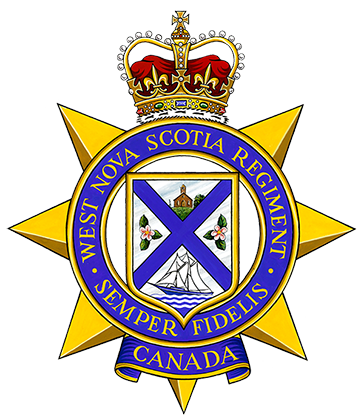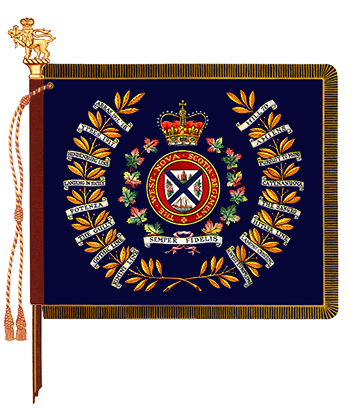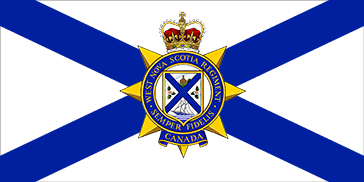The West Nova Scotia Regiment
The official lineage of The West Nova Scotia Regiment infantry regiment.

Badge
Description
Argent on an escutcheon Argent fimbriated Or a saltire Azure between in chief a church on a mount, in base a schooner proper set on barry wavy Argent and Azure, and in the flanks two mayflowers leaved proper, all within an annulus Azure edged and inscribed WEST NOVA SCOTIA REGIMENT and SEMPER FIDELIS in letters Or, ensigned by the Royal Crown proper and resting upon a scroll Azure edged and inscribed CANADA, the whole surmounting a mullet of eight points Or.
Symbolism
The crown represents service to the Sovereign. The shield includes several symbols of Nova Scotia. The saltire or cross of St. Andrew, the patron saint of Scotland, refers to the province's Scottish heritage; the mayflower is the province's floral emblem; the schooner, inspired by the famous Bluenose, symbolizes the sea-faring communities of the South shore, and the church represents the memorial church at Grand-Pré and thus the Annapolis Valley in general and the province's Acadian heritage. "WEST NOVA SCOTIA REGIMENT" is a form of the regimental title and "SEMPER FIDELIS" is the motto of the regiment.
Motto
SEMPER FIDELIS (Always faithful)
March
Quick March
"God Bless the Prince of Wales"
Slow March
"Garb of Old Gaul"
Alliance
British Army
Duke of Lancaster's Regiment
Regimental colour

Camp flag

Battle honours
The War of 1812
Honorary Distinction
The non-emblazonable honorary distinction DEFENCE OF CANADA – 1812-1815 – DÉFENSE DU CANADA
The First World War
ARRAS, 1917, '18; HILL 70; YPRES, 1917; AMIENS; HINDENBURG LINE; PURSUIT TO MONS.
The Second World War
LANDING IN SICILY; Valguarnera; ADRANO; Catenanuovo; Centuripe; SICILY, 1943; Landing at Reggio; Potenza; Gambatesa; THE SANGRO; Castel di Sangro; The Gully; CASSINO II; Gustav Line; LIRI VALLEY; Hitler Line; Melfa Crossing; GOTHIC LINE; LAMONE CROSSING; RIMINI LINE; San Martino-San Lorenzo; San Fortunato; Savio Bridgehead; ITALY, 1943-1945; Apeldoorn; NORTH-WEST EUROPE, 1945.
South-West Asia
AFGHANISTAN
Lineage
This Reserve Force regiment originated on 8 October 1869 and incorporates the following regiments.
The West Nova Scotia Regiment originated in Paradise, Nova Scotia on 8 October 1869, when 'The First Regiment of Annapolis County Volunteers' was authorized to be formed.Footnote 1 It was redesignated the '69th The 1st Regiment of Annapolis County' on 5 November 1869.Footnote 2 On 1 September 1898, it was amalgamated with 'The 72nd or Second Annapolis Battalion of Volunteer Militia' (see below) and redesignated the '69th "Annapolis" Battalion of Infantry'.Footnote 3 It was redesignated: '69th Annapolis Regiment' on 8 May 1900;Footnote 4 and 'The Annapolis Regiment' on 29 March 1920.Footnote 5 On 15 December 1936, it was amalgamated with 'The Lunenburg Regiment' (see below) and redesignated 'The West Nova Scotia Regiment'.Footnote 6 It was redesignated: '2nd (Reserve) Battalion, The West Nova Scotia Regiment' on 7 November 1940;Footnote 7 'The West Nova Scotia Regiment' on 1 November 1945;Footnote 8 'The West Nova Scotia Regiment (Machine Gun)' on 1 October 1954;Footnote 9 and 'The West Nova Scotia Regiment' on 11 April 1958.Footnote 10
Notes:
Upon redesignation as The Annapolis Regiment on 29 March 1920 (see above), it was organized as a two battalion regiment with the 1st Battalion (112th Battalion, CEF) on the Non Permanent Active Militia order of battle, and the 2nd Battalion (no CEF designation) on the Reserve order of battle. The reserve unit was disbanded on 14 December 1936 (GO 3/37).
The Annapolis Regiment was disbanded for the purpose of reorganization on 1 March 1922 and reorganized the same day (GO 101/22). This change was administrative and does not affect the lineage of the regiment.
The Annapolis Regiment was disbanded for the purpose of amalgamation on 14 December 1936 and reorganized the next day (GO 205/36). This change was administrative and does not affect the lineage of the regiment.
The 72nd or Second Annapolis Battalion of Volunteer Militia originated in Wilmot, Nova Scotia on 14 January 1870, when 'The 72nd or Second Annapolis Battalion of Volunteer Militia' was authorized to be formed.Footnote 11 On 1 September 1898, it was amalgamated with the '69th The 1st Regiment of Annapolis County', as above.
The Lunenburg Regiment originated in Lunenburg, Nova Scotia on 12 August 1870, when the '75th Lunenburg Battalion of Infantry' was authorized to be formed.Footnote 12 It was redesignated: '75th Lunenburg Regiment' on 8 May 1900;Footnote 13 and 'The Lunenburg Regiment' on 29 March 1920.Footnote 14 On 15 December 1936, it was amalgamated with 'The Annapolis Regiment', as above.
Notes:
Upon redesignation as The Lunenburg Regiment on 29 March 1920 (see above), it was organized as a two battalion regiment with the 1st Battalion (219th Battalion, CEF) on the Non Permanent Active Militia order of battle, and the 2nd Battalion (no CEF designation) on the Reserve order of battle. The reserve unit was disbanded on 14 December 1936 (GO 3/37).
The Lunenburg Regiment was disbanded for the purpose of amalgamation on 1 May 1923 and reorganized the same day (GO 121/23). This change was administrative and does not affect the lineage of the regiment.
The Lunenburg Regiment was disbanded for the purpose of amalgamation on 14 December 1936 and reorganized the next day (GO 205/36). This change was administrative and does not affect the lineage of the regiment.
Perpetuations
‘1st and 2nd Battalions, East Annapolis Regiment (1812-15)’, ‘1st and 2nd Battalions, King’s County Regiment (1812-15)’, ‘1st and 2nd Battalions, West Annapolis Regiment (1812-15)’, '112th' and '219th "Overseas" Battalion(s), CEF'
Headquarters Location
Aldershot, Nova Scotia
Operational history
The First World War
Details of the 69th Annapolis Regiment were placed on active service on 6 August 1914 for local protection duties.Footnote 15
Details of the 75th Lunenburg Regiment were placed on active service on 6 August 1914 for local protection duties.Footnote 16
The 112th Battalion, which was authorized on 22 December 1915 as the '112th "Overseas" Infantry Battalion', CEF,Footnote 17 embarked for Great Britain on 23 July 1916.Footnote 18 It provided reinforcements for the Canadian Corps in the field until 7 January 1917, when its personnel were absorbed by the '26th Reserve Battalion, CEF'.Footnote 19 The battalion was disbanded on 15 August 1918.Footnote 20
The 219th Battalion, which was authorized on 15 July 1916 as the '219th "Overseas" Infantry Battalion', CEF,Footnote 21 embarked for Great Britain on 12 October 1916.Footnote 22 It provided reinforcements for the Canadian Corps in the field until 23 January 1917, when its personnel were absorbed by the '17th Reserve Battalion, CEF'.Footnote 23 The battalion was disbanded on 15 September 1917.Footnote 24
The Second World War
The regiment mobilized 'The West Nova Scotia Regiment, CASF' for active service on 1 September 1939.Footnote 25 The unit embarked for Great Britain on 21 December 1939.Footnote 26 It was redesignated the '1st Battalion, The West Nova Scotia Regiment, CASF' on 7 November 1940.Footnote 27 It landed in Sicily on 10 July 1943, and in Italy on 3 September 1943, as part of the 3rd Infantry Brigade, 1st Canadian Infantry Division.Footnote 28 On 19 March 1945, the battalion moved with the 1st Canadian Corps to North West Europe, where it fought until the end of the war.Footnote 29 The overseas battalion was disbanded on 15 October 1945.Footnote 30
On 1 June 1945, a second Active Force component of the regiment was mobilized for service in the Pacific theatre of operations under the designation '3rd Canadian Infantry Battalion (The West Nova Scotia Regiment), CASF'.Footnote 31 The battalion was disbanded on 1 November 1945.Footnote 32
South-West Asia
From 2002 to 2014, the West Nova Scotia Regiment reinforced various CAF units deployed to Afghanistan.Footnote 33